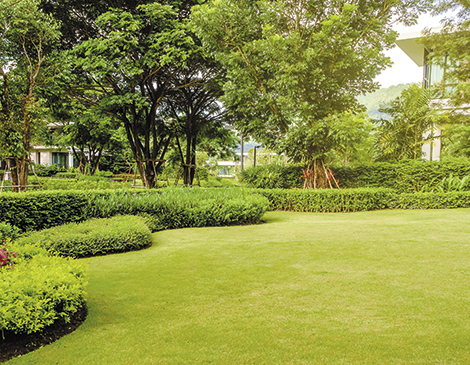For some, the dream isn’t homeownership, but a healthy glade of green to run along the sidewalk. However, common misconceptions around lawn care can threaten this, especially regarding watering. “We always hear that ‘If I don’t water my lawn, my lawn’s going to die,’ ” says Mike Geary, senior client care manager at Green Impressions Landscaping in Sheffield. “The grass around here is actually what’s called cool season lawn. It’s genetically designed to go dormant during periods of excessive heat. Once we get into fall, it gets cooler. Your lawn comes back to life.” Geary gives us answers to three common questions around watering.
When is the best time to water my lawn?
When the first soft light of morning gives itself to the earth, that’s the best time to water your lawn. This gives the water plenty of time to evaporate throughout the day so it doesn’t become susceptible to disease. Keep the hose turned off later in the day. “Watering in the evening is a big thing you want to avoid,” Geary says. “With heat comes humidity, so the humid nights can really set disease off.”
How should I water my lawn?
During dry months, typically July and August, a thirsty lawn — especially a sodded one — can benefit from a built-in irrigation system or underground sprinkler. When the system is not adjusted according to the seasons, however, the result is overwatering and waste. Geary reassures a modest budget can have a lawn that thrives on a simple sprinkler or good old-fashioned rain. “Natural rainwater is always going to win out,” Geary says. “In addition to the water, it provides additional nitrogen which is important for plant growth.”
How do I know if my lawn needs to be watered?
A lawn that is browning may not mean it needs water. Geary warns hose-wielders it could be a sign disease has started due to overwatering. Ideally, grass needs a weekly inch of water. Geary suggests placing a measuring cup on your lawn to keep track of water as it builds up to that weekly inch. “An excess [of water] causing ponding could actually harm the lawn,” says Geary. “If the water’s sitting there for 24 hours or more, then you either have compacted soils or not a good drainage system.”
Choose Your Blade: Garden supply buyer at Petitti Garden Center, Roger Bolger, shares three kinds of lawn grass that withstand Northeast Ohio’s cool-season temperament.
Fine Fescue Grass
It’s not uncommon for many homeowners to have a lawn sheltered by one or two whispering trees. In turn, a fine fescue grass is perfect for enduring a shaded yard that isn’t sun-kissed all the time. “They will do OK with only maybe four hours of sun a day, whereas the others need at least six,” says Bolger. Its deep roots also allow the fescue to compete with trees for nutrients.
Kentucky Bluegrass
Kentucky bluegrass requires more care, like watering during dry weather, on account of its intolerance to heat, but its ability to self-heal is a plus. Not only is this dark, vivid green grass nice to look at, it also has strong, self-spreading roots — or runners — that make for a thicker lawn. “If you get a dead patch in the lawn, the grass will fill in on its own,” Bolger says.
Perennial Ryegrass
For some, perennial ryegrass’ susceptibility to fungal diseases, such as rust from nearby plants hosting airborne spores, might make it an unfavorable choice for lawn grass. However, its perks include sprouting quickly — a mere five to seven days — and a natural resistance to insects. “It produces chemicals inside of it that are bad for insects. Some varieties have been bred for that for lawns,” says Bolger.
Turf Invasion: Pesky weeds tend to invade even the best of lawns. Best Greening Services business manager Jackie Machock profiles the usual suspects to look out for.
Crabgrass
Sometimes mistaken for tall fescue grass, this straggly, insidious weed spreads like a web across the yard. Ever the opportunist, it invades spots where grass is weak, then bullies it out during dry periods. “The thicker your grass is, the more naturally you’re keeping weeds out because they’re looking for easy spots to grow,”says Machock.
Ground Ivy
The lighthearted nickname “Creeping Charlie” hardly cloaks ground ivy’s vindictive nature. The scalloped leaves creep in from neighboring yards or unmaintained flower beds and thrive off of moisture. “If you leave it alone, it chokes out sections of the lawn,” Machock says. Mowing regularly around three inches can help the lawn push against unwanted invaders.
Oxalis
While a clover’s nitrogen can keep a lawn healthy, oxalis pushes grass out and weakens the turf. Similar in appearance to the four-leaf plant, this weed shows its true colors when its flowers bloom yellow or purple instead of white. “[Oxalis] can go from seed to pretty large literally overnight,” Machock says. Keeping your lawn healthy and thick through fall seeding and feeding is a natural deterrent.




